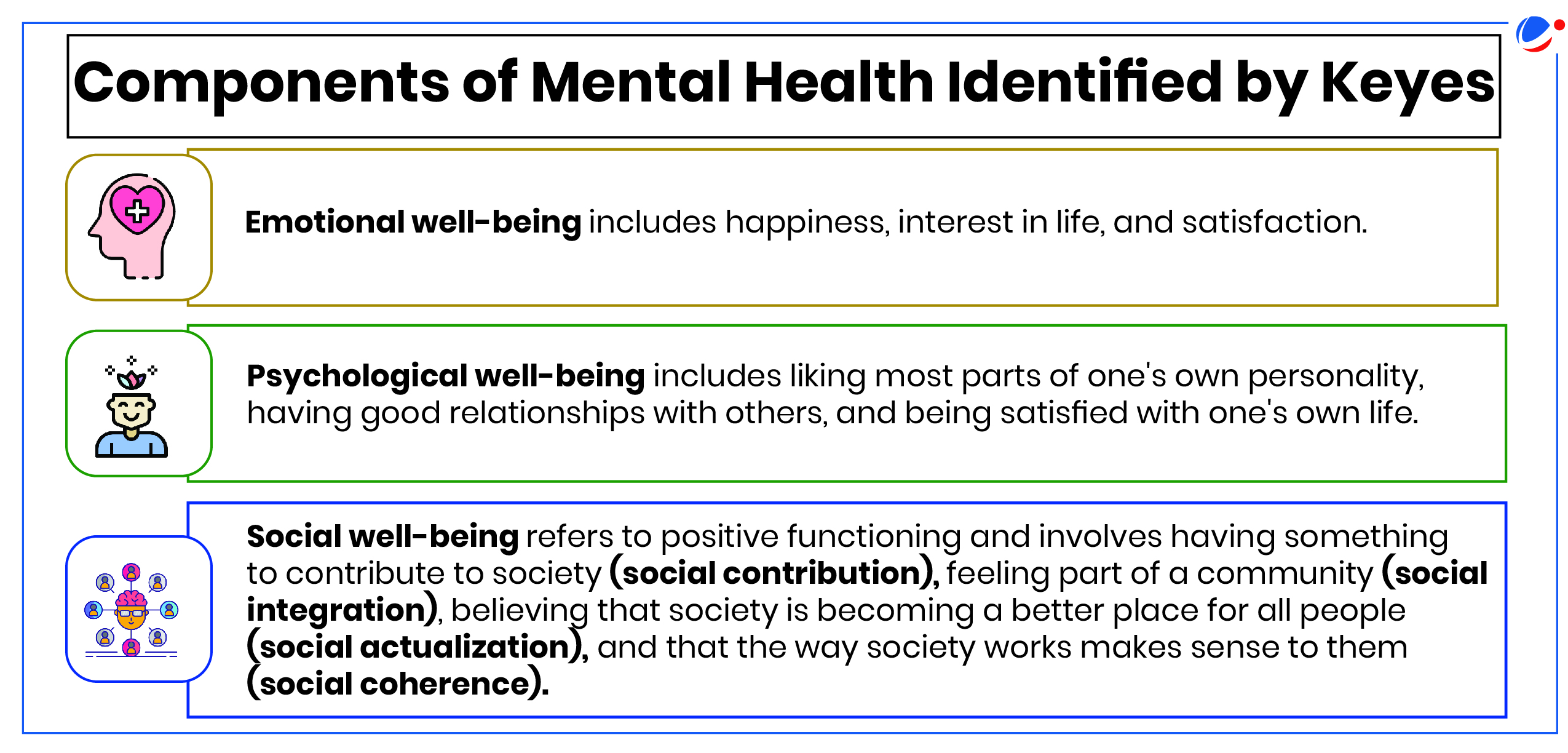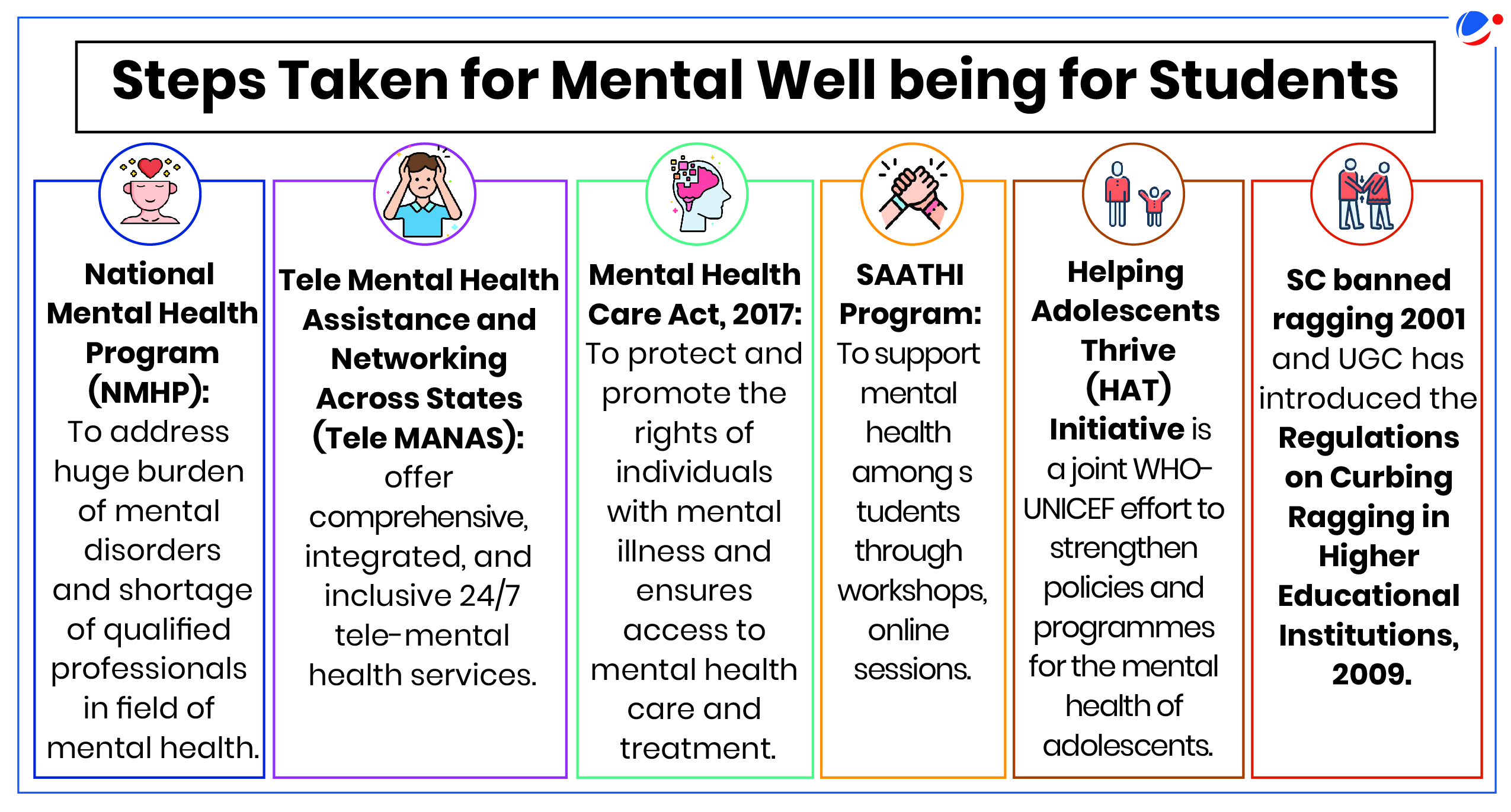Why in the News?
National Task Force for Mental Health and Wellbeing of Medical Students submitted its report in response to alarming incidents of suicides by medical students in last five years.
More on news:
- Report emphasizes the high prevalence of depression among Indian medical students.
- The Commission's online survey showed that a whopping 27.8 per cent of undergraduate students had mental-health conditions and 31.3 per cent of postgraduate students had suicidal thoughts.
- A study by the National Institute of Mental Health and Neurosciences (NIMHANS) found that 23 percent of school children in India have mental health problems.
- National Mental Health Survey (2015–2016) reported a 7% prevalence of psychiatric disorders in 13–17 years and was nearly equal among both the genders.
- A study conducted by schizophrenia research foundation (SCARF) in Chennai found that over 30% of students suffer from anxiety and depression.
What is mental health?

- It is a "state of well-being in which every individual realizes his or her own potential, can cope with the normal stresses of life, can work productively and fruitfully, and is able to make a contribution to her or his community." (WHO)
- Mental health is best understood as a resource, one that allows individuals to recognize and understand their skills and potential that they may use to pursue their passions and dreams within sport.
Factors contributing to mental health problems among students:
- Immediate Triggers/Precipitating Factors:
- Immediate triggers for mental health crises among students include financial loss, sudden grief, mental health deterioration, and adverse life events such as failing exams or public humiliation E.g. Suicides in IITs.
- Influence of Social Media: A 2018 British study tied social media use to decreased, disrupted, and delayed sleep, which is associated with depression, memory loss, and poor academic performance.
- Social isolation and loneliness: dysfunctional family dynamics, hormonal changes and issues gender identity during teenage.
- Intense combination of relentless academic pressure, financial sacrifice, and high parental expectations are also key factors behind students suicide in places like Kota.
- Predisposing Biological Factors:
- Genetic predispositions, such as alterations in gene expression and family history of suicide, can increase suicide risk by affecting brain function and behavior.
- Certain personality traits like impulsivity, along with disabilities and major physical illnesses, may also elevate risk by contributing to feelings of isolation, stress, and depression.
- Stigmatization: Because of stigma against seeking mental health care issues are not identified at the initial stage.
Issues with handling mental care in India:
- Fragmented approach: Insufficient Integration into Primary Healthcare results in a fragmented approach to mental healthcare
- Geographical disparities in Infrastructure and Resources: Rural & remote areas, often lack necessary infrastructure
- Shortage of Mental Health Professionals: Only 0.75 psychiatrists/lakh population in India (Economic Survey 2023-24).
- Lack of Awareness and Stigma leads to discrimination, social isolation, and prejudice against individuals seeking help.

Way-forward
- Implement Regular Training Programs: Conduct regular training sessions for faculty to identify and support students at risk.
- Counseling Services: A 24/7 Support System should be implemented across schools and colleges. This can be done quickly by implementing TeleMANAS initiative using the toll-free number (14416) in all colleges.
- Early detection and treatment: Sensitization of front-line health workers and teachers to mental health challenges to identify at-risk individuals at an early stage.
- Children and adolescents require special attention considering that around half of all mental health disorders start by the age of fourteen years.
- Policy reforms and resource allocation: By Allocating Adequate Resources, Prioritizing Mental Health in the Healthcare Agenda and adopt an integrated approach that addresses mental health's biological, psychological, and social determinants.
- Digital Detox Programs: Encouraging students to balance digital activities with physical exercise, hobbies, and offline social interactions can help mitigate the negative impacts of excessive digital use.
- Practicing self-awareness: Students can improve mental well-being by practicing self-awareness, mindfulness, and regular exercise, while also maintaining healthy sleep and eating habits to reduce anxiety and build emotional resilience.




